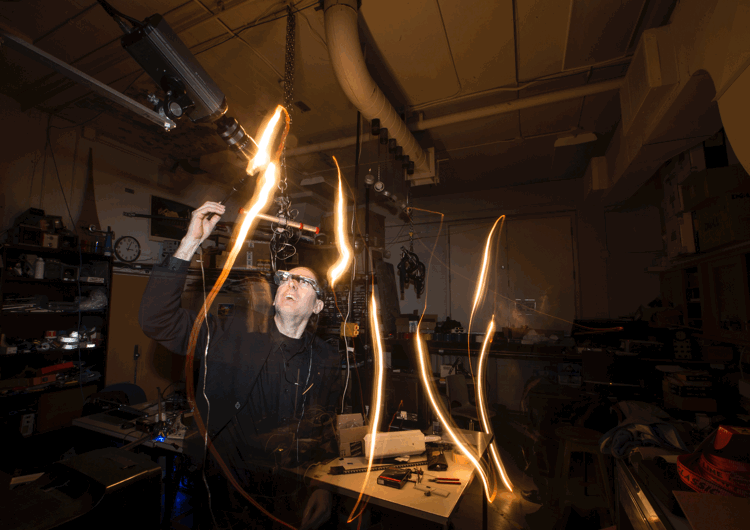This article is part of a series called The Future is Smart: How the Internet of Things is changing business
Follow the series at tgam.ca/internet
Decades before the likes of the Fitbit and Apple Watch adorned the wrists of tech-savvy trendsetters, Hamilton, Ont.-born Steve Mann strapped a computer to his head and started to experiment with wearable computing.
The man – once dubbed by the media as “the world’s first cyborg” – attracted more than a few naysayers in the seventies, when he began trudging around with loads of gear and a set of ungainly rabbit ears cropping out of his skull.
Known as “the father of wearable computing,” the computer engineering professor at the University of Toronto has spent more than three decades with one eye in the real world, and the other focused on augmediated reality – a term he uses to describe a deliberate modification to a person’s perception of the world. It’s one phrase in a vast lexicon of terms he’s coined to describe his work with wearables.
“People used to really think of this technology as ‘other,’ but I think we’re kind of crossing over the other side,” Mr. Mann, 53, said in a recent interview at his lab, surrounded by his gadgets spanning musical instruments to fitness gear.
While Mr. Mann has been working to miniaturize his wearables over the years – and had ditched the rabbit ears and much of the bulk by the time he reached the Massachusetts Institute of Technology as a grad student in the nineties – more and more devices have been coming online every year. He and his colleagues at MIT once referred to this ever-increasing number of network-enabled devices as “things that think.” Today, it’s better known as the “Internet of Things.” And while IoT technology offers to streamline and automate a multitude of everyday activities, it also guarantees to collect an inordinate amount of data and make the world a lot less private.
“The Internet of Things is a giant data vacuum cleaner,” said Adam Thierer, a senior research fellow who specializes in technology policy at George Mason University’s Mercatus Center in Virginia.
“Basically these technologies, and especially wearables, will be collecting all of our daily footprints. Some of the most intimate details of our lives will now be tracked in real time – right down to things that even maybe happen in your bedroom,” he added.
While no one doubts the privacy concerns, experts are at odds over how the IoT and wearables fit together.
Mr. Mann considers each an entirely separate technology. IoT devices are surveillance technology, he says, while wearables are “sousveillant” technology, or devices that record activities from the perspective of the participant. The scientist coined this term as well, deriving it from the French word “sous,” meaning “below,” as opposed to “sur,” meaning “on.”
For Mr. Mann, wearables work to offset the privacy concerns surrounding the IoT by offering everyday people the chance to collect the same data accumulated by IoT technology.
“Some people say surveillance is good, other people say surveillance is bad, I say you’re both wrong,” Mr. Mann said, wearing the EyeTap digital eyeglass device he invented long before anyone had heard of Google Glass. “Surveillance is only a half-truth. Without sousveillance, it’s out of balance.”
Most people collecting personal data outside science labs like Mr. Mann’s, however, do so through popular devices like smartwatches or fitness trackers sold by tech giants that store their customers’ data on their own networks. What they do with that data and how closely it’s guarded from potential hackers is where privacy concerns arise.
“I think there are real dangers there,” Mr. Thierer said. “Because at some point the question becomes who has access to that data, what is that data correlated with and what decisions will be made based on that data.”
Mr. Thierer thinks, for example, insurance companies could begin adjusting premiums for health or car insurance as a result of the data wearables collect. How advertisers, employers and governments may use the data are other areas of concern.
From his lab, Mr. Mann is quick to point out that wearables don’t have to be Internet-dependent. He thinks “Internet” is simply too limiting a word, and that wearables eventually will be able to run on a broad range of networks, not just today’s dominant one.
Though not connected to large corporate cloud networks, Mr. Mann’s wearable computers are capable of connecting to wireless networks – Internet or otherwise – if they’re attached to a WiFi device. In fact, he performed the world’s first wireless livestream in the early nineties using a hand-built communication system.
While most of his inventions are not available for purchase, he’s hopeful that his work – and that of his students – will offer alternatives to today’s increasingly popular wearable devices and mitigate some of the growing privacy concerns surrounding the IoT.
“Many people regard Toronto as the birthplace of wearable computing,” Mr. Mann said. “So Canada has kind of become the epicentre of that sort of thing, and still is in many ways.”
